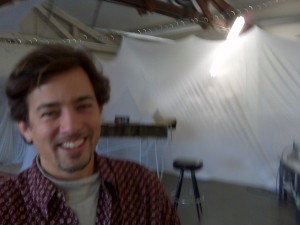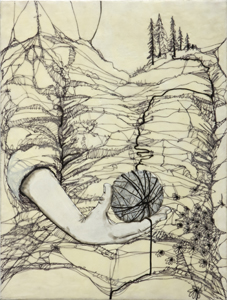Portland loves process — a politician here can barely duck out for coffee without holding several public meetings first to thrash out which coffee shop she should hit in which geographically underserved corner of the city — and that extends to its arts scene.
 Lectures, tours, workshops, open rehearsals: If it’s a behind-the-scenes peek, we’re there. It’s not enough just to see the finished project. We want to know how it got there.
Lectures, tours, workshops, open rehearsals: If it’s a behind-the-scenes peek, we’re there. It’s not enough just to see the finished project. We want to know how it got there.
What was the idea? How was it built? What were the stumbling blocks? Was getting there really half the fun?
In the visual arts, something else kicks in, too: sweet reassurance.
Galleries and museums intimidate a lot of people. They don’t know the language. They might know what they like, but they suspect the cognoscenti would laugh at them. In galleries, they think they’re getting the once-over (and in a few, they are): Is this person a potential buyer? Does she count? Is she worth my time?
It’s not so much that people are afraid of wrestling with tough ideas, it’s that they’re afraid they don’t know the rules. They’re not specialists — and in the minds of the many, the art world has become the province of the anointed few. (In certain rigorously theoretical cases, of course, this is true.) Add to all this the sense of mystery — the popular idea that with artists, something magical happens, beyond the ken of mortal souls — and it’s little wonder that fear keeps people outside the gallery doors.
In fact, the actual making of art is usually a tactile, pragmatic, hands-on thing; down-to-earth in a sometimes literal sense. For all the metaphorical calisthenics in writing about art, artists themselves tend to be practical problem-solvers: What is this thing that’s wormed inside my head, and how can I work it out? Most artists grapple with chance and improvisation more than most of the rest of us, but the good ones do it with method and structure. In spite of C.P. Snow’s famous lament in The Two Cultures (or maybe in support of it), the worlds of art and science aren’t all that far apart, at least in a rudimentary sense. Both involve hypothetically based searches for truth, and in that search both find beauty.
 So let’s take the pressure off and take a relaxed look at how this art stuff really works. That’s part of the idea behind Portland Open Studios, the annual fall tour of artists’ studios across the greater Portland area. In its 10th year, the event includes 100 studios (they’re juried in) and runs the next two weekends: October 10-11 and 17-18. Most studios are open both weekends; the Web site has details.
So let’s take the pressure off and take a relaxed look at how this art stuff really works. That’s part of the idea behind Portland Open Studios, the annual fall tour of artists’ studios across the greater Portland area. In its 10th year, the event includes 100 studios (they’re juried in) and runs the next two weekends: October 10-11 and 17-18. Most studios are open both weekends; the Web site has details.
It’s always fun to see where other people work. I visited three studios before the kickoff, and each represented a different approach to the artist’s workspace.
Bonnie Meltzer‘s studio in North Portland is a storybook sort of place, a small building steps away from the back door of an old farmhouse on a double lot that also holds gnarled fruit trees and a pretty terrific vegetable garden. The studio strikes a balance between orderly and cluttered, with all sorts of tools that a home handyman would be comfortable with, and a motley collection of globes destined to find their way at one point or another into her mixed-media works. A deck outside the studio is set up for sawing and bashing at big pieces of stuff.
Encaustic artist Andrea Benson works from a small studio at Troy Studios, a big brick former commercial laundry building in industrial Southeast Portland that’s home to about 25 artists. She can bike or walk there from her home, and likes having a separate space. A few blocks away, Mar Ricketts, whose fabric pieces range from aerodynamic kites and mobiles to temporary structures for big outdoor events, works in a big single-story space that allows plenty of floor room for laying out his sometimes gargantuan pieces. His studio isn’t a recycled industrial space: It is an industrial space.
Continue reading Portland Open Studios: what’s behind the gallery walls